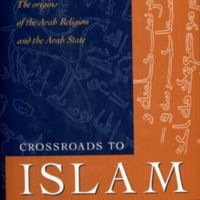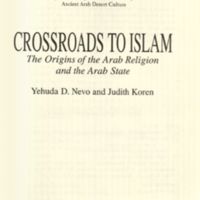Crossroads to Islam: The Origins of the Arab Religion and the Arab State
Dublin Core
Title
Crossroads to Islam: The Origins of the Arab Religion and the Arab State
Subject
Islam -- Origin
Islam -- History
Arabs -- Religion
Arabian Peninsula -- History
Byzantine Empire -- History -- 527-1081
Islam -- History
Arabs -- Religion
Arabian Peninsula -- History
Byzantine Empire -- History -- 527-1081
Description
"In Crossroads to Islam, Yehuda Nevo and Judith Koren offer a controversial exploration of the early history of Islam, presenting a revolutionary theory of the origins and development of the Islamic state and religion from the early 7th to the mid-8th century C.E. Many Western scholars recognize the difficulties of accepting the validity, as historical evidence, of the huge body of Muslim literature, with its detailed account of the rise of Islam in the Arabian Peninsula and the subsequent, religiously inspired invasion of the settled lands beyond; for this literature only started to be written 150 years after the period it purports to describe. But until now, there was little with which to replace it. Nevo and Koren examine in detail the available contemporary evidence, most of which has not been seriously taken into account by most historians of early Islam. It includes official documents and inscriptions of the early Arab State; archaeological excavations and artifacts; legends on coins; and hundreds of Arabic rock inscriptions." "Based on their analysis of this evidence. Nevo and Koren outline a rethinking of the early history of Islam. They argue that the Byzantine Empire withdrew before the Arab Takeover; that the resulting power vacuum led to competition among local Arab chiefs to widen their sphere of control; and that Mu'awiyah was the first historical caliph. They document the evidence that the Arabs were initially pagan and trace the development of Islam from a simple "Indeterminate Monotheism," adopted by Mu'awiyah, to the Muslim faith of the late 2nd century A.H. ("after the bijra": the Muslim era, which counts from 622 C.E., year Muhammad fled to Madinah according to the Muslim sources), in which period they also place the canonization of the Qur'an. The origin of the Arab Prophet, introduced by the caliph 'Abd al-Malik around 690 C.E., is another central issue addressed by the authors' new theory."--Jacket.
Creator
Yehuda D. Nevo
Publisher
Amherst, NY : Prometheus Books
Contributor
Judith Koren
Relation
Series: Islamic studies (Amherst, N.Y.)
Table Of Contents
Introduction: The Traditional Account and Its Problems -- The Background -- The Foundering of Empire -- The Byzantine East on the Eve of Invasion -- The Role of the Church -- The Demographic Background -- The Takeover and the Rise of the Arab State -- The Takeover -- Political Events: The Evidence of Contemporary Texts -- The Evidence of the Coins -- The Foundation of the Arab State: A Suggested Reconstruction -- The Arab Religion -- The Religious Background -- Religious Events: The Evidence of Contemporary Texts -- The Chosen Prophet -- The Official Faith: Mohammedanism and Walid's Islam -- From Monotheism to Islam: Religious Development in the Popular Inscriptions -- Scripture and Salvation History -- Quranic and Non-Quranic Versions of Locutions -- The pre-Diocletianic provincial borders -- The provincial borders after Diocletian's changes -- The provincial borders in the late 4th century C.E. -- The provincial borders in the 5th century, after ca. 425 C.E. -- Mint towns of Arab-Byzantine coins -- Minting activities around Bisapur.
Text Item Type Metadata
Original Format
Book
Citation
Yehuda D. Nevo , “Crossroads to Islam: The Origins of the Arab Religion and the Arab State,” Humanities Hub, accessed December 24, 2025, https://humanitieshub.sdsu.edu/omeka/items/show/1021.


